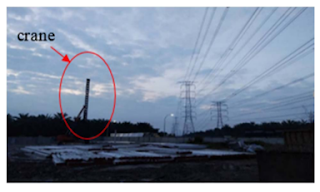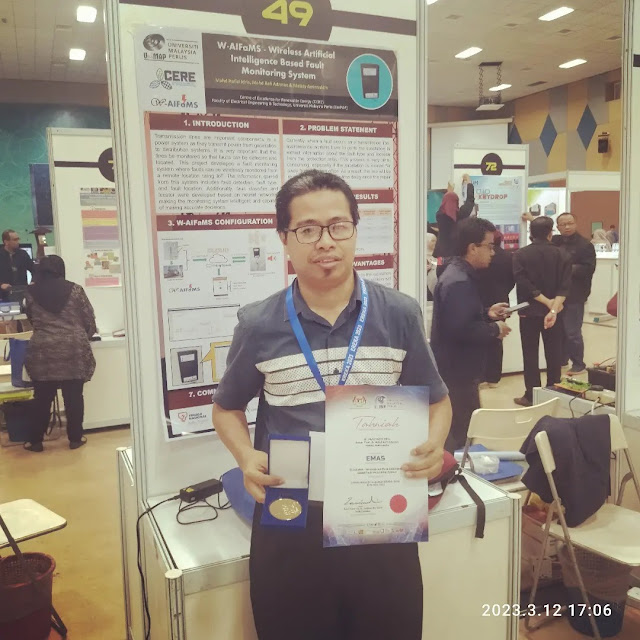On December 20, 2023, I and my students studying Power System Protection & Switchgear visited the Perlis Power Plant for an industrial tour. The aim was to give students hands-on exposure to a crucial element of the power system—the power plant. Initially, we received a comprehensive briefing on the power plant's operations, covering organizational structures, company management, operational systems, and power generation control. This particular plant employs a combined cycle system, relying on natural gas as its primary fuel source for generating electricity. Within this setup, there exist two main turbines: the primary turbine, fueled by burning natural gas, and the secondary turbine, activated by steam derived from the primary turbine's combustion heat. Following the briefing, participants had the opportunity to witness various parts of the power plant installation, including the turbine room, step-up transformers, grid connections, water storage facilities, and the power generation control room (SCADA).
Working as senior lecturer and researcher at Faculty of Electrical Engineering & Technology, Universiti Malaysia Perlis (UniMAP). Research Interests: Power System Fault Location, Power System Simulation & Modelling, Fault Location in Power System, Internet of Things (IoT) and Renewable Energies.
Restricted Earth Fault (REF) Relay
Restricted Earth Fault (REF) relay is used as a primary protection alongside differential relays for safeguarding transformers from ground faults in both the high-voltage (HV) and low-voltage (LV) windings.
Each HV and LV winding has its own REF relay. This relay isn't able to detect phase-to-phase faults or three-phase faults (without touching the ground) because its protection boundary is from the CT on one side (primary/HV) to the CT connected to the neutral on the primary/HV side of the primary/HV winding.
For the secondary/LV winding, the protection boundary is from the secondary/LV side CT to the CT connected to the secondary/LV neutral.
The REF relay can be used to protect both Y-Y and Y-Delta transformers. In the case of a Y-Delta transformer, the neutral earthing resistor (NER) is connected to the secondary/LV winding to provide a neutral connection for return current and transformer connection.
Figure 1 illustrates the operation of the REF relay. When a ground fault occurs in either the primary/HV or secondary/LV winding, no current flows through one of the CTs (input to the REF Relay), resulting in residual current entering the REF relay, exceeding the pickup current setting. The relay then sends a signal to the Master Trip relay, which subsequently sends a tripping signal to both breakers, the primary/HV, and the secondary/LV. There's no tripping delay as the REF relay acts as the primary protection for the transformer alongside the Differential relay.
Causes of Faults at Transmission Line
Transmission line faults can arise due to various reasons, and they can be categorized into several causes:
1. Weather Conditions - Adverse weather conditions like lightning, heavy storms, strong winds, ice, or snow can cause faults by physically damaging the transmission lines or creating conditions conducive to electrical faults.
2. Equipment Failure - Malfunction or failure of components such as insulators, conductors, transformers, switches, etc can lead to faults along the transmission line.
The Difference between Transient & Permanent Faults
Transient Fault
- Transient faults are those that disappear when power is interrupted and then restored.
- Often caused by occurrences like lightning, momentary tree contact, or contact with animals.
- In such cases, the line can be successfully re-closed after it's been tripped.
Permanent Fault
- Permanent faults persist even when power is restored.
- These faults stem from prolonged issues such as tree or crane encroachment, insulation breakdown, tower collapse, or cable damage.
- Reclosing the line fails because the fault persists during the attempt to restore it.
Involved in STEM Program at Primary School Sekolah Kebangsaan Paya Kemunting, Jitra, Kedah.
Science, Technology, Engineering and Mathematic (STEM) program was conducted at SK Paya Kemunting (SKPK), Jitra, Kedah in collaboration with FKTE, FKTEN & IEEE UniMAP. Various exhibitions, games & STEM-based activities were held involving the participation of 290 level 2 students from SKPK. The program's objective is to cultivate students' interest in STEM. The Deputy Director of PPD Kubang Pasu also attended the program. Congratulations to the faculty, staffs involved and the management of SKPK. This program is a part of out university social responsibility (USR).
Joined Ekspo Rekacipta UniMAP (EREKA 2023)
I joined the EREKA (Ekspo Rekacipta UniMAP) competition, which was organized by the Centre for Innovation and Commercialization (CIC) UniMAP with the cooperation of the Office of Deputy Vise Chancellor for Research and Innovation, UniMAP. The competition was conducted from 10th to 12th March 2023.
My innovation project title is "W-AIFaMS - Wireless Artificial Intelligence Based Fault Monitoring System".
My innovation project has been awarded with GOLD medal.
Industrial Visit to HVDC Converter Station, Gurun, Kedah
HVDC Converter Station, Gurun, Kedah is a high-voltage direct current (HVDC) electrical power conversion station located in the Malaysian state of Kedah. It converts alternating current (AC) electricity generated by power plants into direct current (DC) electricity for long-distance transmission, and vice versa. HVDC technology is used to transmit large amounts of electrical power over long distances with minimal power loss.
This converter station is located in Gurun, Kedah and is connected to converter station at Khlong Ngae, Thailand through 300 kV DC transmission line. This HVDC grid connection increase the power system stability and security for the grid at North region of Peninsular Malaysia by connecting the grid of both countries.












.jpeg)